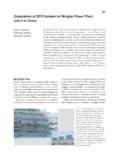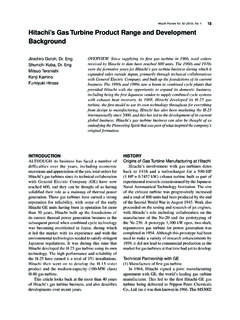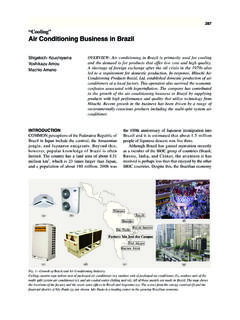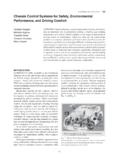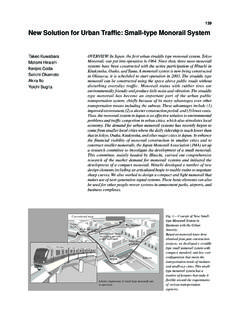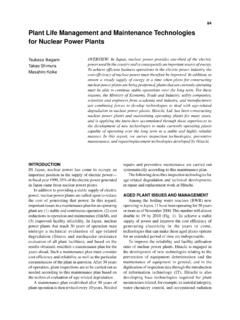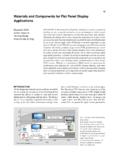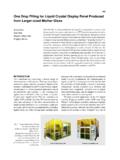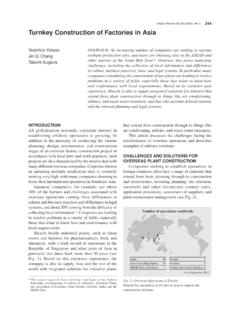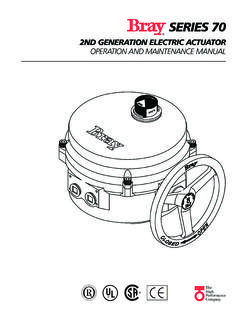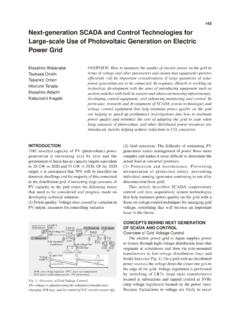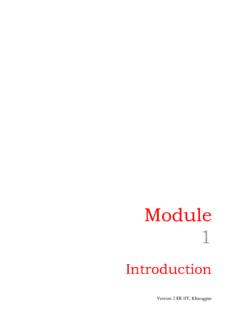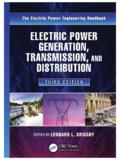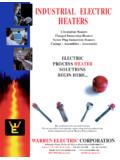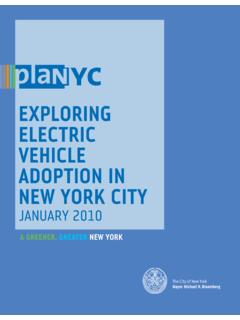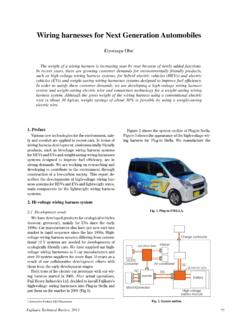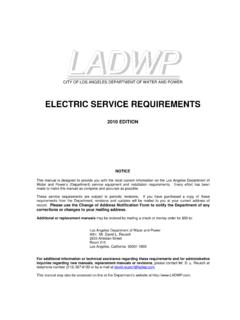Transcription of High-power-density Inverter Technology for Hybrid and ...
1 Hitachi Review Vol. 63 (2014), No. 2 96 - 41 - High-power-density Inverter Technology for Hybrid and electric Vehicle ApplicationsTakashi KimuraRyuichi SaitouKenji KuboKinya NakatsuHideaki IshikawaKaname SasakiOVERVIEW: Green vehicles have become familiar sights on the road in recent years, with growing sales of HEVs and the arrival of the fi rst mass production BEVs. With environmental regulations on CO2 (fuel economy) and exhaust emissions also becoming increasingly stringent, sales of these green vehicles are set to increase further in the future. Consequently, because electric drive systems are made up primarily of electric motors, inverters, and batteries, inverters are being called on to fulfi ll increasingly diverse roles and there is a need to decrease their size and cost while increasing their output.
2 Along with supplying inverters for HEVs and EVs that are an ideal match with customer requirements, Hitachi also intends to continue contributing to progress toward a low-carbon society by developing technologies that will help make inverters more widely the aim of creating a sustainable society, vehicle fuel economy standards are becoming progressively tighter year by year in order to reduce carbon dioxide (CO2) emissions. It is forecast that the proportion of the total market accounted for by electric vehicles (EVs) and Hybrid electric vehicles (HEVs) will grow signifi cantly by 2020. HEVs have been commercialized in a variety of forms. Hitachi draws on its strengths in power electronics to supply inverters that suit diverse customer has been demand in recent years to increase the output and reduce the size of inverters so that they can fi t into the limited space available in vehicles.
3 In response, Hitachi has developed new power modules with double-sided direct cooling that deliver considerably higher power density than past models. Hitachi has also developed a standard power electronics platform for mounting these power modules, and has commercialized it in the form of a standard article describes the power modules with double-sided direct cooling used in automotive inverters, the confi guration of the standard Inverter , Hitachi s own direct current (DC) converter that is integrated into the Inverter , and the steps Hitachi is taking to increase Inverter output WORKA utomotive inverters accelerate or decelerate the vehicle by converting the DC power from the batteries to alternating current (AC) at the frequency required for vehicle speed and other system control to control the electric motor speed, drive torque, and power .
4 The performance requirements for these electric drive systems for HEVs and EVs are small size (important for ensuring that the system can be installed in the vehicle), high effi ciency to extend EV range, high output to provide suitable acceleration performance, and reliability to operate in the harsh environment inside a utilizing its technologies for package structure of power module to develop a direct water cooling system, Hitachi has succeeded in delivering both small size and high performance. It is also working on making its inverters smaller still by adopting a double-sided cooling method with direct water cooling and fully immersed cooling fi ns (see Fig. 1).Depending on the type of drive used, electric drive systems require an Inverter capable of driving one or two electric motors.
5 For compatibility with the motor and battery, they also need to operate at a variety of system voltages, such as 60 V or less, or 100 450 V. Hitachi commenced full-scale production of HEV inverters with direct cooling in 2005, producing models capable of driving one or two motors and operating at 42 V. power modules with single-sided direct cooling were used up to the second generation, and double-sided direct cooling was adopted from the third generation onward. Hitachi has also developed its standard Inverter to achieve greater sharing of parts between models (see Fig. 2).97 High-power-density Inverter Technology for Hybrid and electric Vehicle Applications- 42 -TECHNOLOGIES FOR INVERTERS WITH high power DENSITYF eatures of High-power-density InverterThe requirements for automotive inverters include control performance that extends from low to high motor speeds, robustness to withstand a harsh environment (heat and vibration), electromagnetic compatibility (EMC) performance to minimize the radiation of electromagnetic noise due to heavy current switching, ease of installation (small size and light weight), failsafe functions in the event of a fault, long life with respect to thermal fatigue, excellent water and dust proofi ng, and insulation performance at high altitude.
6 The inverters also need to satisfy these demanding requirements at a low inverters incorporate a wide variety of components, including insulated-gate bipolar transistor (IGBT) power devices, power modules, high -voltage DC line capacitors, main circuit busbars, a power module drive circuit board, a motor control circuit board, three-phase current sensors, and DC and heavy-current AC connectors. Delivering the expected high performance has in the past required the use of special-purpose components. The components used in the high -voltage and heavy-current power sections of the Inverter required a high level of insulation and the ability to withstand high a result, Hitachi has set out to reduce costs by standardizing components, and is seeking to satisfy diverse customer needs by designing inverters that use these standardized newly developed High-power-density Inverter has the following features.
7 (1) Use of power modules with low thermal resistance, and IGBTs and diodes with low losses and high performance199720052008(Fiscal year) Inverter output power density (relative)Generation IGeneration IICoolingwaterCoolingwaterThermalgreaseH eat-dissipatingbase with finsCoolingfinsIGBTIGBTI nsulatingsubstrateInsulatingsubstrateGen eration IIII ndirectwater coolingDirect water coolingDouble-sideddirect watercooling20112014 Fig. 1 Development Roadmap for HEV/EV satisfy the diverse requirements for automotive use, Hitachi is achieving smaller size and higher performance by utilizing engineering and analytical technologies taken from numerous different fi elds, including the electric power , industrial, and consumer sectors, to develop direct water : Hybrid electric vehicle EV: electric vehicle IGBT: insulated-gate bipolar transistor 2002(Year)Elf(Isuzu Motors Ltd.)
8 Volt(General Motors Company)Malibu(General Motors Company)eSLS(Daimler AG)First-generation strong (I)First-generation mild (M)Second-generation strong (II)Third-generation strong (III)DevelopmentExamplevehicles200320042 0052006200720082009201020112012201320142 0152016 MTahoe(General Motors Company)Fig. 2 Use in commenced full-scale production of inverters with direct cooling in 2005, and has supplied three generations of high -output inverters to Review Vol. 63 (2014), No. 2 98 - 43 -(2) Design with a low-inductance main circuit and optimized DC capacitance(3) Water channel design that combines efficient cooling with low pressure loss(4) Use of an application-specifi c integrated circuit (ASIC) with built-in protection functions for gate drive(5) Motor control circuit board designed for functional safety(6) Compact package design with small size and light weight(7) Miniaturized auxiliary Inverter (option)Double-sided Direct-cooling power ModulePower DevicesThe IGBT and freewheeling diode (FWD) power devices need to deliver the performance required by the vehicle when operating at its maximum limits.
9 As power devices account for the bulk of losses in an Inverter , they have a signifi cant impact on electrical effi ciency. Accordingly, the power devices need to have low losses. Hitachi has achieved low losses by adopting the latest device Technology available at the time for each of its Inverter generations (see Fig. 3).As the maximum DC link voltage is about 400 V (assuming no voltage booster is used), IGBTs need to be rated for 650 to 700 V. Other likely design requirements are an effective current of 300 to 400 Arms and a carrier frequency of 5 to 12 kHz. To achieve low losses under these operating conditions, and to reduce Inverter size, Hitachi has adopted fi eld-stop, trench IGBTs for its third-generation ModulesThe requirements for power modules are to minimize Inverter fl oor space and to get the best performance out of the power devices.
10 Hitachi has been using direct cooling since its fi rst- and second-generation models. For direct cooling, the fi ns on the base of the module are immersed in cooling fl uid. This improves heat dissipation because it dispenses with the heat sink thermal resistance and the thermal grease used in the past between the base plate and heat sink (see Fig. 4).The pin fi n design is critical to direct cooling. While having more fi ns reduces the thermal resistance, it increases the pressure losses in the cooling water channels. Hitachi uses a genetic algorithm to optimize the design of its pin fi ns (see Fig. 5). The optimum pin fin design needs to be selected based on the required thermal resistance and the pressure loss determined by the requirements specified for the electric drive system s cooling system.
